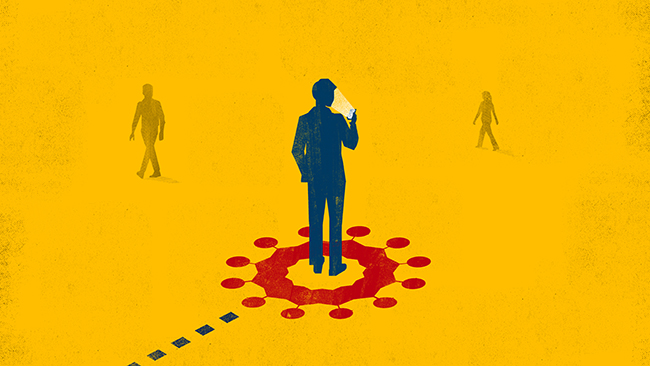Welcome to the inaugural edition of Ready or Not, a monthly newsletter from the Oliver Wyman Forum providing insight on today’s most challenging problems for business, public policy, and social enterprise leaders.
Today, we look at how data can help track and control the coronavirus to enable a faster economic recovery in the coming months - and in possible future waves of the pandemic. Countries around the world have taken widely different approaches, reflecting their privacy rules and cultural norms. There is no single data solution that will work for everyone, but every nation should be able to develop an effective strategy consistent with its political and social traditions.
Countries that get data-sharing right will emerge stronger than those that choose to fly blind or stick with blunt containment measures. And employers will have to play a crucial role in assuring workers and customers that it’s safe to go back to the office.
In building models, epidemiologists and economists seek to predict when health risks will lessen, consumer demand will return, and businesses, schools, and other organizations can resume something approaching normal operations. That involves as much art as science because no one knows how much social distancing and other measures slow the virus’ spread, or how strongly it may re-emerge when governments loosen those restrictions.
Such uncertainty produces very different forecasts. The US Centers for Disease Control and Prevention tracks 14 models with projections for the national death toll by June 1 that range from around 80,000 to more than 150,000. On May 4, the University of Washington’s Institute for Health Metrics and Evaluation nearly doubled its projection for US fatalities, to some 134,000 by August 4, because of the easing of lockdown measures. The medium term is even murkier. Oliver Wyman’s model, the Pandemic Navigator , projects there could be several cycles of infection over 12 or more months after the current wave peaks, requiring repeated tightening and relaxation of suppression measures. The takeaway: Managers should resist making decisions based on any single model and instead prepare for a range of scenarios. All will demand greater agility and flexibility, with many staff continuing to work from home at least in the near term. Employers also will have to do much more to keep their employees and customers healthy and safe.
Just as 9/11 changed the way we travel, the COVID-19 pandemic will transform how we work. Employees will need to be screened for symptoms, offices redesigned to eliminate shared equipment and close quarters, and policies changed to address everything from liability issues to crisis management. Businesses need to move quickly on several fronts. |
1. Decide Who, When, and How to Return to the Office Employers should prioritize who needs to be on site. Maintaining or expanding work-from home can provide extra time and space for the adjustment. Workers should return to the office in phases and be separated into teams to ensure backup if anyone gets sick and quarantines are necessary. If possible, split employees across multiple sites and limit visitors and travel to reduce risks. 2. Clean and Assure Businesses will need to ensure that buildings are appropriately cleaned multiple times a day. Workplaces must be redesigned to reduce physical contact and encourage social distancing with one-way corridors, touchless doors, and no shared seating. Personal protective equipment such as gloves and face masks should become the norm to protect workers and customers. Facilities also may need structural improvements to ensure that heating, air conditioning, and air filtration systems protect workers. 3. Encourage Employee Participation in Testing and Tracing Widespread coronavirus testing and contact tracing data is crucial for business to resume. That will help the authorities better predict the pandemic’s trajectory and management prevent outbreaks among staff. Businesses need to encourage employees to get tested regularly and to isolate themselves and inform their managers if they get sick. This means offering ample sick-leave and reducing costs of COVID-19 screening and treatment. |
After a surge of infections in late February, South Korea flattened its curve fast while managing to keep the economy open. That extraordinary success was based in large part on contact-tracing data surveillance. The authorities use mobile phone location data, credit card transactions and CCTV to track the movements of anyone who tests positive for the virus, and share that anonymized data on public maps so residents know where they could be exposed.
Privacy concerns and civil rights issues make it difficult for most other democracies to replicate that strategy, but there are still ways to harness data to fight the coronavirus.
All Information is Not Equal
The percentage of people willing to share their data varies by type
The alternative to Korean-style centralized data surveillance is decentralized data volunteerism. Singapore pioneered this privacy-safe method with TraceTogether, a voluntary app that uses encrypted mobile Bluetooth signals to enable health officials to quickly identify people who infected individuals may have exposed. Australia is urging its citizens to use an almost-identical contact-tracing app, and similar tools are being rolled out in Germany, the UK, and the US.
But a glaring challenge remains: More than a month after launch, only about a quarter of Singapore’s population uses the app. An Oxford University study estimates that around 60 percent of the population has to participate for such an app to be fully effective. Our research has found that there are four types of people, and they are motivated differently to share their data. Designing the apps and information campaigns to address those differences could improve participation.
Here’s where business can and should step in. By teaching employees about the importance of contact tracing and why decentralized technologies won’t violate privacy, they can encourage broader participation. That will help us fight this pandemic and get the economy moving again. This approach also can pay dividends for the future, showing how powerful open data can be when it is used safely and smartly.

Epidemiologist and deputy editor of ProMED
"I live a block and a half from a medical emergency room. When I’m working in my study, I hear the sirens constantly. You don’t hear people walking by. You don’t hear cars very much. What you hear is ambulances. It takes a toll when the only sound you hear is sirens. I don’t scare easily, but this one has me scared on a global level and on a personal level. It is going to take a lot longer to feel more comfortable about global and personal safety."

